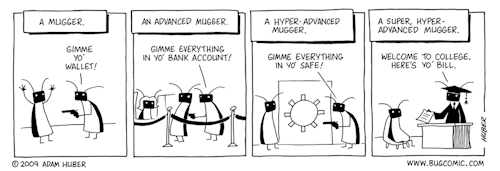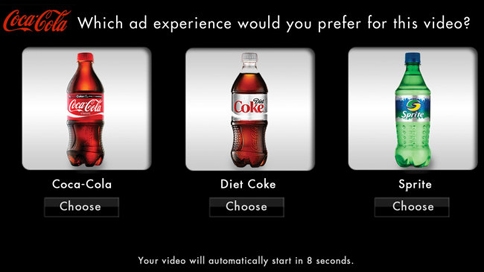VisCult Fall 2011
Tuesday, December 13, 2011
Inanimate Faces
http://www.youtube.com/watch?v=iIoUZufXTfw&feature=youtu.be
-Kristin
Thursday, December 1, 2011
A Super Hyper-Advanced Mugger

I saw this comic and couldn't resist keeping it to myself. What better outlet than our visual culture blog?
Saturday, November 26, 2011
The Future of Advertising


All of these techniques are relatively new, especially compared to the history of advertising and I’m very interested to see how far it will go. With the integration of social media into our everyday lives, I can see the potential for highly personalized, relevant advertising that might be so well integrated you might not even notice it is happening. One example of this might be product placement in movies that would change based on the viewer. As much as we want ads to go away, I think they are here to stay. They are just going to get smarter.
Friday, November 25, 2011

The Livestrong Foundation was created, in 1997, by world-renowned cyclist, Lance Armstrong, a year after he was diagnosed with cancer. After beating the caner, he went on to win seven consecutive (1999-2005) Tour-de-France races, the most prestigious bike race in the world, setting a new world-record for consecutive wins. The Foundation was created to raise money for cancer research and awareness.
In 2003, the Livestrong.org website was created specifically for people affected by cancer. One-on-one help was available as well as other practical materials to help members battle cancer .
In 2008, the Livestrong.com website was launched. The site is built to encourage people to take control of their own healthy living. It is geared towards the population at-large and not just those with cancer. The site contains interactive applications that help people in the areas of: fitness, diet, wellness and lifestyle. Some of the applications include:

- My Plate: online food tracker (largest food database)
- Loops: online fitness tracker and map tracker
- My Quit Coash: online smoking cessation program
- Recipes: online database for healthy recipes and for recipes created by members
Livestrong.com provides articles, videos and Q & A's from reputable, expert sources. And the site provides links to other related articles that fit your search criteria.
What makes Livestrong.com a new media source is it's interactive nature. Member's are free to give input to the editor's of the site and therby, content is constantly being monitored and updated to fit their needs. Also member's can form forums and groups to share their health stories, concerns and successes with others, making it a place of community.
As the 2009 New Media Award winner, I predict Livestrong.com will continue to be a trusted site for information concerning health and wellness. Its library and content will continue to grow as the world's population continues to increase its awareness of the importance of healthy living.
Sunday, November 20, 2011

Google+ at first glance seems to be yet another social media platform available to us, but after watching a few videos and reading a few articles, I think Google+ offers something new.
"Real-life sharing,
rethought for the web."
I do believe that their tagline rings true. Google has offered a way to make sharing very simple, but a different way of sharing from Facebook and Twitter. The three components of Google+, Circles, Hangouts and Games, allows users to immediately specify which of their friends they want to or need to share things with. It provides social activity and presentation in a new way. We also can't forget it's search engine and mobile features.The intimacy and specificity of this social platform is what I think will cause it to continually rise in popularity. Google+ is not only just a social platform for families and friends, but it is now open to businesses. ---> http://www.youtube.com/user/Google#p/u/4/ozxfUtgySlo
I think this was a brilliant idea! Although some would argue that they don't want to see more advertising on yet another social platform, I think it fosters a great environment for companies (whether big or incredibly small) can be more interactive with their customers.
I now have a greater appreciation for Google+ and predict that it will reach it's peak within the next 3 years as they improve it with the help and feedback of it's users.
The YouTube Phenomenon
 YouTube has a surprisingly short history, and yet marks the beginning of the cultural phenomenon that is Digital Cinema. Video sharing was not simple before YouTube. This challenge sparked three young adults working at the internet company, PayPal, to establish a video sharing website that we know and love as YouTube today.
YouTube has a surprisingly short history, and yet marks the beginning of the cultural phenomenon that is Digital Cinema. Video sharing was not simple before YouTube. This challenge sparked three young adults working at the internet company, PayPal, to establish a video sharing website that we know and love as YouTube today.Friday, November 18, 2011
The New and Improved Battery

· Battery advancements have been slow and have barely able to keep up with the other advances in cell phone technology.
· In the past advances have had to be in processor and display efficiency, in order to better use that limited store of power
· Other advances have been delayed because of the limitations of the inner workings of batteries. Inside batteries, there are innumerable layers of graphene, a one-atom-thick sheet of carbon atoms. Batteries can only charge as quickly as the Lithium ions move from one sheet of graphene to the next. In the past, scientists have tried using silicon instead of the layer of carbon, which lead to the battery charging much faster. However, silicon is less durable and the material would expand and contract, causing it to break to quickly for the battery to be efficient.
2. Also they thought of perforating the graphene sheets, allowing ions to take a “shortcut” to the next layer. They call these 10-20nm holes “in-plane defects,” result is Charging is ten times faster. "Even after 150 charges, which would be one year or more of operation, the battery is still five times more effective than lithium-ion batteries on the market today," says lead author Harold H Kung.
· It has been estimated that these new batteries could be on the market in three to five years. The process has changed enough that existing manufacturing techniques are likely insufficient, so it would involve a lot of previous phones and handheld gaming systems to be completely extinguished from the market. Most likely in the future, all phones will use this method or one similar. This will enable users less charging time. People will likely only have to charge their devices once a week.
· In speculation this will also enable other developments in phone technology that zap more power, things that cell phones have not previously been capable of due to power restrictions. Maybe the iphone myth of a holographic keyboard will actually come true. This tech could also lead to more energy efficient cell phones. As charging will require less time and electricity and will last longer. Eventually we might be able to find the right combination of materials to create a battery that you only have to charge every few months or once a year.